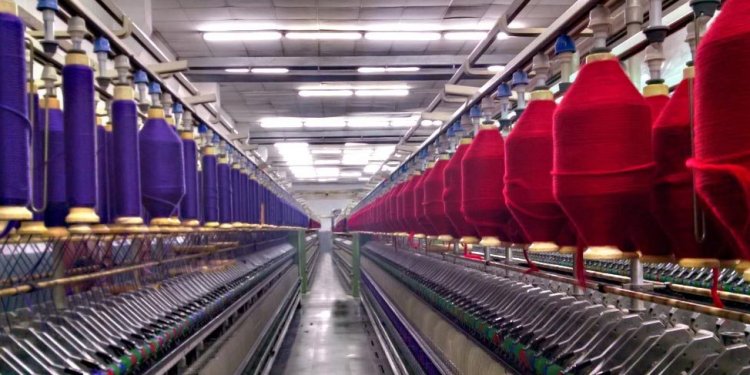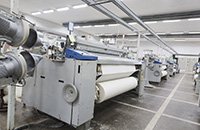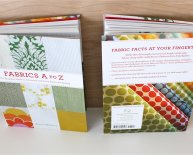
What are textile Mills?
 A textile mill is a manufacturing facility where textiles, or types of cloth, are produced or processed into finished products, such as clothing. At a mill, raw natural fibers, such as cotton and wool, and synthetic fibers, such as nylon and polyester, are combined, carded and drawn out into long strands before they are spun into yarn, and wound onto special reels called bobbins. Depending on the type of material or product, the yarn is then ready for pressing, weaving, crocheting or knitting.
A textile mill is a manufacturing facility where textiles, or types of cloth, are produced or processed into finished products, such as clothing. At a mill, raw natural fibers, such as cotton and wool, and synthetic fibers, such as nylon and polyester, are combined, carded and drawn out into long strands before they are spun into yarn, and wound onto special reels called bobbins. Depending on the type of material or product, the yarn is then ready for pressing, weaving, crocheting or knitting.
The final steps in textiles production are dyeing and finishing, where fabrics and other textiles are colored, have designs printed on them, and are treated to keep them from shrinking, fading, wrinkling, and/or soiling easily.
Historically, textile mills were highly labor intensive, but in modern textile mills, specialized machinery perform most of the work.
There are a few different textile mill worker job specialties identified by the U.S. Bureau of Labor Statistics, including:
| Textile Mill Specialty | Job Responsibilities |
|---|---|
| Textile winding, twisting, and drawing out machine setters, operators, and tenders | Set up, operate or tend machines that wind or twist textiles, or draw out and combine sliver, such as wool, hemp or synthetic fibers |
| Textile knitting and weaving machine setters, operators and tenders | Set up, operate or tend machines that knit, loop, weave or draw in textiles |
| Textile bleaching and dyeing machine operators and tenders | Operate or tend machines to bleach, shrink, wash, dye or finish textiles or synthetic or glass fibers |
| Inspectors, testers, sorters, samplers and weighers | Inspect, test, sort, sample or weigh nonagricultural raw materials or processed, machined, fabricated or assembled parts or products for defects, wear and deviations from specifications |
| First-line supervisors/managers of production and operating workers | Directly supervise and coordinate the activities of production and operating workers, such as inspectors, precision workers, machine setters and operators, assemblers, fabricators, and plant and system operators |
The Industrial Revolution is largely responsible for the growth of textile mills, especially when it came to the processing of cotton, one of the most important natural fibers in the world. Although the importance of textiles is still apparent, specialized machinery has long since replaced many workers today. Textiles are currently produced and processed in approximately 18, 800 locations across the nation.
Many of the goods that were produced and processed in textile mills from the 1940s to the 1970s were made with asbestos fibers, which put many textile workers at risk of asbestos exposure. However, those currently working in textile mills could still be at risk if exposed to older machinery, appliances or equipment.
Products and Locations
Textile mill workers were exposed to different types of asbestos products such as:
- Textile Products: Textile mill workers were mainly exposed to asbestos through the raw material that was combined, carded, spun into yarn and then pressed, woven, crocheted or knitted into the products that were produced and processed, especially at mills were fire-resistant products were made, such as fire curtains, roofing felts, welding blankets, fireproof safety clothing, oven mitts and pot holders.
- Thermal Insulation: Fabric-weaving machinery, drying machines and boilers were insulated with asbestos, further exposing workers.
Occupational Exposure
Textile mill workers’ exposure to asbestos is largely the result of direct handling of asbestos that was used to produce textiles. Exposure to airborne asbestos fibers and asbestos-containing insulation around machinery was a concern for all workers in the mill, whether they handled asbestos directly or not. Before strict regulations on the use of asbestos were implemented, the process of converting asbestos into usable fabric was one that involved many different workers and locations throughout the mill.
The asbestos was then delivered to storage, and when workers moved the asbestos from storage, they mixed it with cotton. It was then piled, which meant cotton and asbestos were put in alternating layers on the floor and then fed to a picker machine.
This was followed by carding, the arranging of cotton and asbestos fibers in parallel rows. The asbestos cards were then spun into yarn and wound around spools. This process created an environment in which heavy asbestos exposure was possible. Once carded, the material was spun into yarn and weaved, crocheted or knitted into completely or partially finished products.
It was common for fibers to become disturbed throughout this manufacturing process. This especially happened during the weaving process, where threads are prone to rub together and produce dust and lint, which disperse asbestos fibers and dust into the air. Once these fibers are inhaled, many are expelled, but some can become lodged in organ tissues and remain there throughout life. The accumulation of fibers can cause inflammation and scarring that may lead to the development of mesothelioma cancer and other asbestos-related illnesses.
Textile mill workers were also exposed to asbestos that was used for insulation purposes, such as asbestos cement used to insulate panels of drying machines. Not only did the drying machines themselves contain asbestos insulation, but lint and dust created by the drying machines did as well if asbestos materials were being used. Weaving machinery and boilers also contained asbestos insulation. Because most machinery used to create textile products was insulated with asbestos, all textile workers who had a hand in the manufacturing of textile products were at risk of exposure.
Scientific Studies
A study published in the March 2009 Occupational and Environmental Medicine titled, “Lung Cancer Mortality and Fiber Exposures among North Carolina Asbestos Textile Workers, ” suggests textile workers were exposed to chrysotile asbestos in at least four plants in North Carolina, and that the risk of lung cancer and asbestosis increased with cumulative exposure.

















